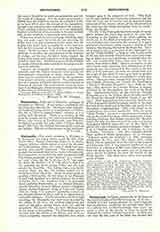

Pentapolis. —The word, occurring in Wisdom, x, 6, designates the region where stood the five cities (Greek: pente, polis)—Sodom, Gomorrha, Segor (A. V., Zoar), Adama, Seboim—which united to resist the invasion of Chodorlahomor (Gen., xiv), and of which four were shortly after utterly destroyed. This region, which marked the southern limit of the territory occupied by the Canaanites, was included in what was known in old Palestinian geography as the “Kikkar” (i.e. “round” or “oval”; Gen., xiii, 10, 11, 12, etc.; D. V. “the country about the Jordan“; A. V. “the plain”), that is to say probably the lower Jordan Valley and the land around the Dead Sea. The Kikkar was a very fertile country (Gen., xiii, 10). Its fertility caused Lot to settle there (Gen., xiii, 8-13). About the same epoch, or possibly a little earlier, the five kings of the Pentapolis had been defeated in a battle fought in the Valley of Siddim (D. V. “the woodland Vale”) by Amraphel (most probably Hammurabi, q.v.), King of Sennaar, Arioch (Rim-Sin), King of Ellasar (Larsa), Chodorlahomor (Kudur-Lagamar), King of Elam and Thadal (Tid al), “king of the nations” (probably countries in the neighborhood of Elam and in its dependence), and made tributary. Twelve years later the five kings revolting, the Pentapolis was once more invaded by the armies of the East, the territory plundered, and captives led away, among whom were Lot and his household. We read in Gen., xiv, how Abraham went to the rescue of his nephew. The Pentapolis soon recovered from the effects of its defeats, and in its restored prosperity renewed the shameful vices which brought upon it the judgment of God. “The Lord rained upon Sodom and Gomorrha brimstone and fire from the Lord out of heaven, and he destroyed these cities and all the country about, all the inhabitants of the cities and all things that spring from the earth” (Gen., xix, 24-25).
The site of the Pentapolis has been sought in many places around the Dead Sea, even in its very bed. According to the holders of the latter opinion, we should see, in the Biblical description of the destruction of Sodom and Gomorrha, the account of a great geological disturbance which caused a sinking of the country, this forming the bed of the Dead Sea. Travellers pointed out as a remnant of the submerged cities the “Rujm el-Bahr”, a ledge of rock to the north of the sea, now entirely covered with water, but forming an island or even a peninsula at periods when the lake was considerably lower than now (as, for instance, from 1848 to 1892). Modern geologists, on the other hand, while admitting that disturbances of that character may have occurred in that region in the last fifty or forty centuries, yet with one accord hold that the origin of that body of water goes back to prehistoric times. The site must accordingly be sought elsewhere. There are some, among them Armstrong, Wilson, Conder, Tristram, and recently Dr. Huntington (“Harper’s Monthly Magazine”, January, 1910, pp. 186 sqq.), who, deceived by a certain likeness in names, searched for the Pentapolis to the north of the Dead Sea. Clermont-Ganneau, on the contrary, thought Gomorrha was in the Arabah, about 60 miles south of the Dead Sea (Recueil d’Archeol. Orient., I, pp. 163 sqq.). Most geographers, however, think that the site of the Pentapolis should be sought partly in the shallow bed of the south end of the lake, and partly in its immediate neighborhood. This view seems to be supported by two serious arguments. First, the name “Jebel Hsdum”, given to a conspicuous mountain of salt on the southwest shore, echoes apparently a long-standing tradition that Sodom was near by. Second, Segor, the only city that survived the ruin, was known throughout Biblical times (Is., xv, 5; Jer., xlviii, 4) and in the early Christian centuries [Joseph., “Ant”, I, xi, 4; “Bellum jud.”, IV, viii, 4; Ptolemy, V, xvii, 5; Euseb., “Onomast.”, 231, 261; Madaba Mosaic Map; medieval Arabic geographers (cf. Le Strange, “Palestine under the Moslems”, p. 292); crusaders (Guillaume de Tyr, xxii, 30); Segor, then called Zoora, was an episcopal see at the time of the Council of Chalcedon, 451]; it was situated southeast of the Dead Sea, at a distance of 580 stadia (almost 66 miles) from the north shore of the same, and to all appearances should be looked for near the mouth of the Wady Qerahy. The other three cities were possibly north of Segor.
CHARLES L. SOUVAY

